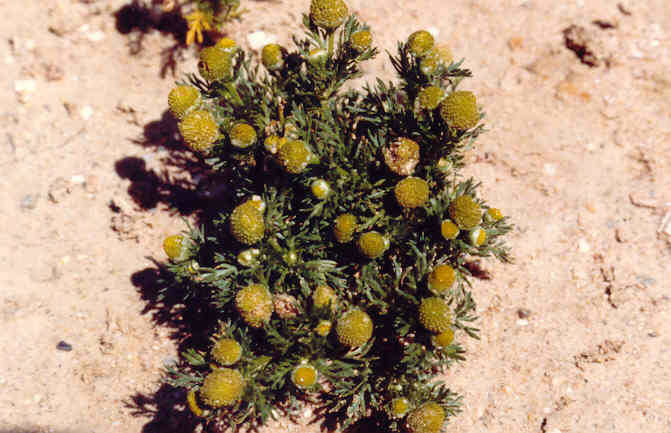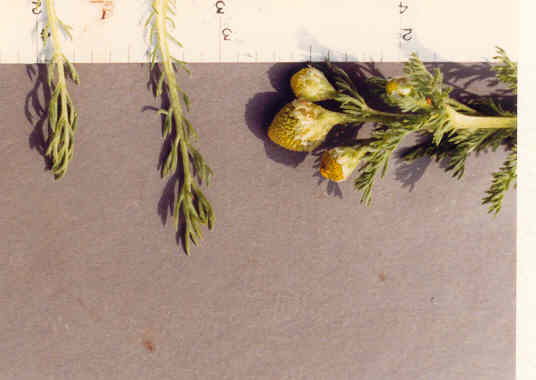
Chamomilla suaveolens (Pursh) Rydb.
=Matricaria matricioides
=M. suaveolens
Asteraceae (Sunflower Family)
Native
 |
Chamomilla suaveolens (Pursh) Rydb.=Matricaria matricioides=M. suaveolensAsteraceae (Sunflower Family)
Native
Pineapple Weed |
April Photo
Plant Characteristics:
Branched, erect, aromatic annual 1-3 dm. high; lvs. 1-5 cm. long, 1-3-pinnatifid
into linear or filiform segms.; heads several to many, rayless, the disk mostly
4-10 mm. wide; disk corollas yellow, 4-6 toothed; phyllaries with broad hyaline
margin, the invol. 5-7 mm. high, much shorter than the conical disk; aks. with 2
marginal and 1 rather weak ventral nerves; pappus a short crown, minute, entire.
Habitat:
Common weed in waste places through most of Calif.; to Alaska, Rocky
Mts., L. Calif., Santa Catalina and Santa Rosa Ids.
Apparently introduced into eastern states. May-Aug.
Name:
Latin, matrix, because used
medicinally. (Munz, Flora
So. Calif. 210). Matricarioides,
like Matricaria. (Jaeger 151,172). Matricaria
derives from its having once been found useful in treating infections of the
uterus. (mater, mother, and caries,
decay). (Crockett 125).
Matricaria, is a genus that has
foliage typical of this species. (John Johnson).
Derivation of the genus name Chamomilla
is not known. (Hickman, Ed. 226).
Latin, suaveolens, sweet
smelling. (Jaeger 251).
General:
Occasional in the study area. Photographed
at 23rd Street and at the northerly end of Eastbluff.
(my comments).
The leaves and flowers were used as medicine by the Indians. ( Heizer and Elsasser 247).
Crush a bit of leaf material of pineapple weed and you will quickly learn
why this epithet has been applied to this plant.
(Crockett 125). The Cahuilla, Indians of the Colorado
Desert, the San Jacinto and San Bernardino Mountains, used an infusion of this
plant to settle upset stomach or cure diarrhea and colic.
(Bean 88). As
a sedative it mixes well with California Poppy, Passion Flower, Wild Oats and
Prickly Poppy. As an intestinal or
uterine antispasmodic, mix with Desert Lavender, Chimja, or True Sage.
(Moore, Medicinal Plants of the
Desert and Canyon West 88).
About 35 species of the Northern Hemisphere and South Africa.
(Munz, Flora So. Calif. 210).
Matricaria, about 35 species, annuals, biennials and perennials-some
aromatic, with flowers to 1 in. across, some grown in gardens.
(Bailey, Hortus III no page
ref.).
Text Ref:
Abrams, Vol. IV 400; Hickman, Ed. 228; Munz, Calif.
Flora 1233; Munz, Flora So. Calif.
210.
Photo Ref:
April 4 83 # 5,6; Mar 2 85 # 18A.
Identity: by R. De Ruff, confirmed by F. Roberts.
Computer Ref: Plant Data 187.
Have plant specimen.
Last edit 9/22/02.
 |
March Photo